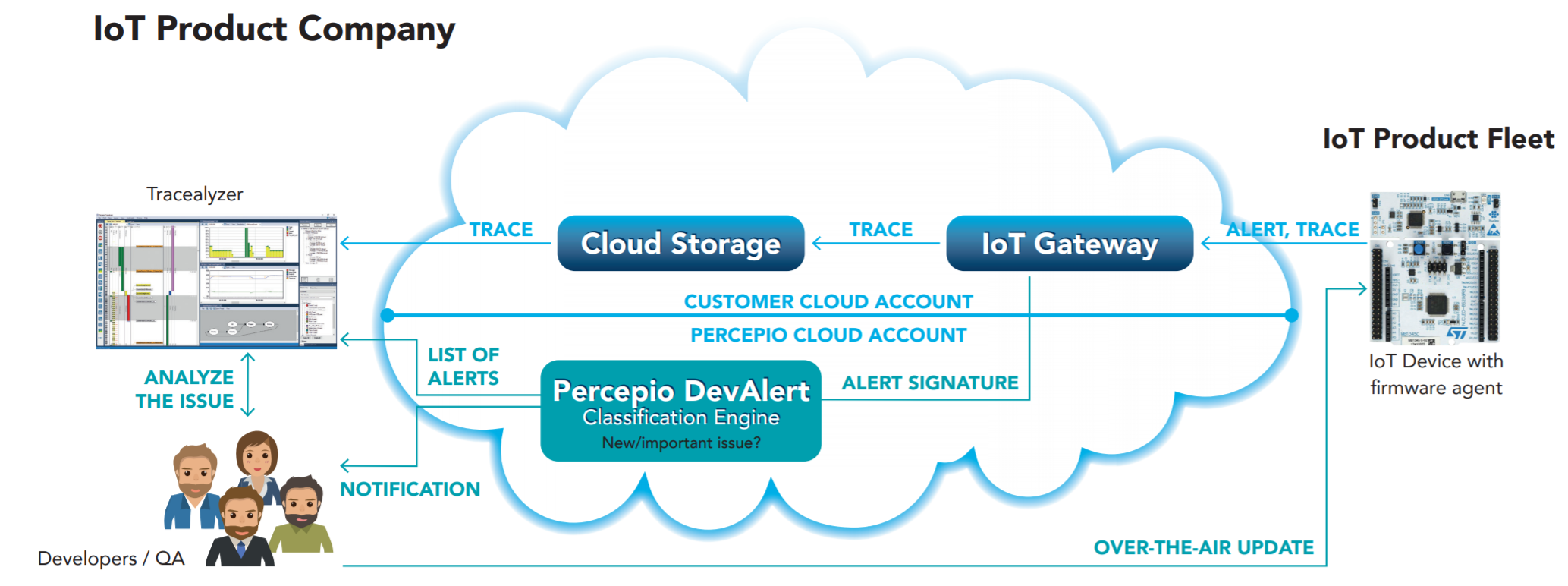- | Home |
- Company |
- Contact |
- News |
- S/ware Eng |
- Standards |
- Academic Support |
- Documents |

- | Requirements |
- Compilers |
- Validation |
- RTOS |
- Analysis |
- Hardware |
- Software |
- Resources |
- Products |

IoT Remote Diagnostics
Percepio DevAlert is a ground-breaking cloud service for IoT product organizations that provides awareness of missed bugs and speeds up resolution. DevAlert notifies the firmware developers within seconds after an error has been detected and provides diagnostic information about the issue, including a trace that shows you what was going on in your code when the error occurred.
DevAlert explained in 40 seconds
Percepio DevAlert allows IoT product organizations stay on top of firmware problems in deployed devices and speed up resolution. When a firmware issue has been detected, DevAlert notifies the developers within seconds and provides diagnostic information about the issue, including a trace for Percepio Tracealyzer. This shows what was going on in the code when the error occurred, making it far easier to understand the problem and quickly find a solution.
Without automatic feedback, you actually rely on your end users to report any issues, a responsibility they have not agreed to. Then you might not hear about the issues until it’s too late, when many customers have already been affected. Moreover, your end users can’t be expected to provide sufficiently detailed information for you to quickly reproduce, debug and solve the problem. A vague error report like “it just crashed” may require weeks of guesswork until you find a likely cause, and even then, you still don’t know if you really solved the right problem. Imagine how much troubleshooting time that could be saved if you instead had access to detailed diagnostic information about every issue in the production software.
Percepio DevAlert is designed to leverage existing secure solutions for cloud connectivity, storage and OTA updates. It initially supports Amazon Web Services (AWS IoT Core), Amazon FreeRTOS and ThreadX, but support for additional platforms is planned and can be provided on request.
Information Flow
The information flow starts in the error handling code of the IoT device, such as sanity checks and fault exception handlers. By calling the DevAlert firmware agent from these locations, firmware issues are uploaded as alerts to the customer’s cloud account. An alert may include an error message and any other information relevant to the specific issue, such as software state variables and hardware registers. Depending on the severity of the issue, the alert is either uploaded directly or after a device restart, once the cloud connection has been restored.
Click image for full size version
Your Information Is Secure
The software trace never leaves the customer’s cloud account. Only an anonymous signature of the issue is provided to the Percepio DevAlert Classification Engine and this information is completely transparent and configurable for the customer. Furthermore, all communication and storage is protected using best practices for authentication and encryption.
Since DevAlert focuses on the behavior of the device software and does not identify the device users, it is not subject to privacy legislation such as GDPR.
Cloud-Side Operational Costs
DevAlert does not generate any data traffic unless an issue is detected, so if you don’t have any missed bugs in your code, there is no DevAlert activity that drives cost. You need to store the alerts for some time, but due to the small amount of data per alert (typically 5 KB) and today’s cheap cloud storage, this is a negligible cost. Especially when compared to the value of the provided information. Say that you have a large fleet of one million devices, with a lot of firmware issues – say 1 alert per device and week on average, and each alert is 5 KB. This would produce about 260 GB per year. Storing this data for a year would cost about $72, assuming Amazon S3 standard storage. But since most data can be deleted after a short time, e.g. duplicates of the same issue from different devices, the storage needed can be reduced to a fraction of this level.
Sending out OTA updates in response to DevAlert notification can somewhat more costly, at least for large device fleets, but this must be compared to the alternative cost of letting a serious bug remain unfixed – damaged customer experience, reduced product sales, or even accidents and legal action. In case of minor issues, it may be sufficient to include the bug fix in the next planned update.
Learn More
Does this sound interesting? Please contact us at info@phaedsys.com to learn more and get started.
